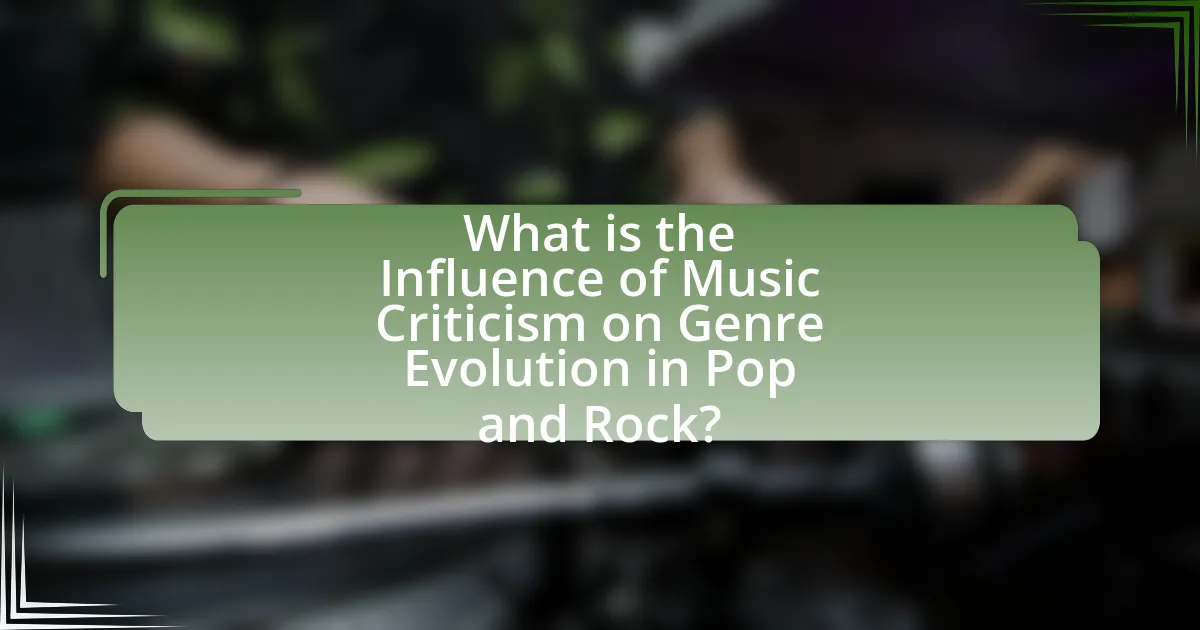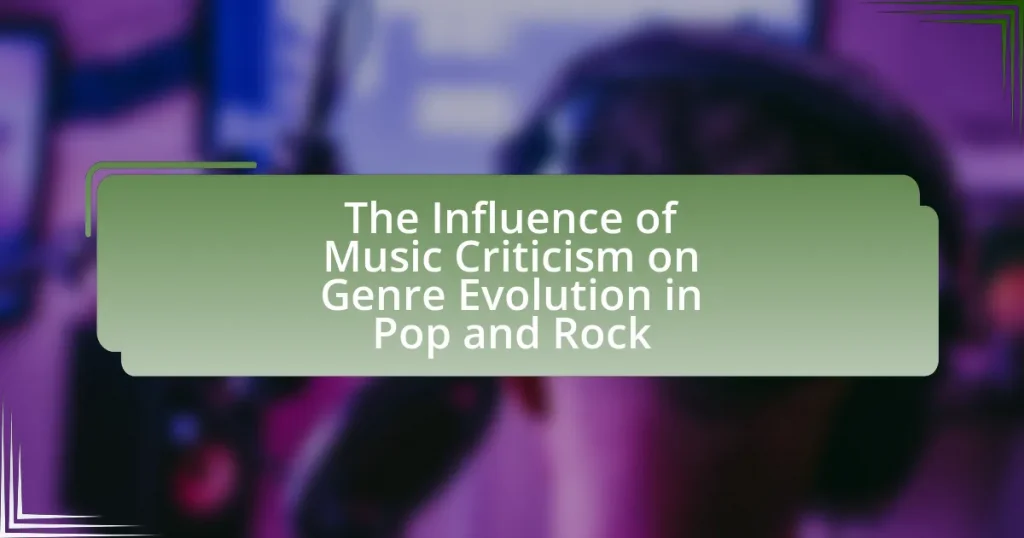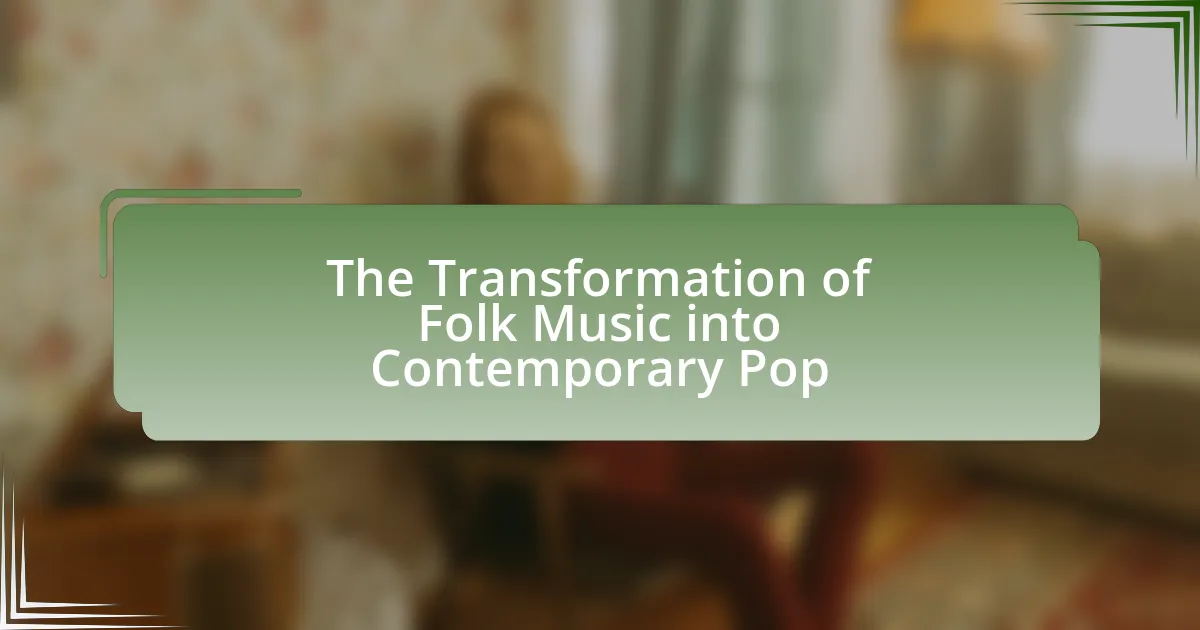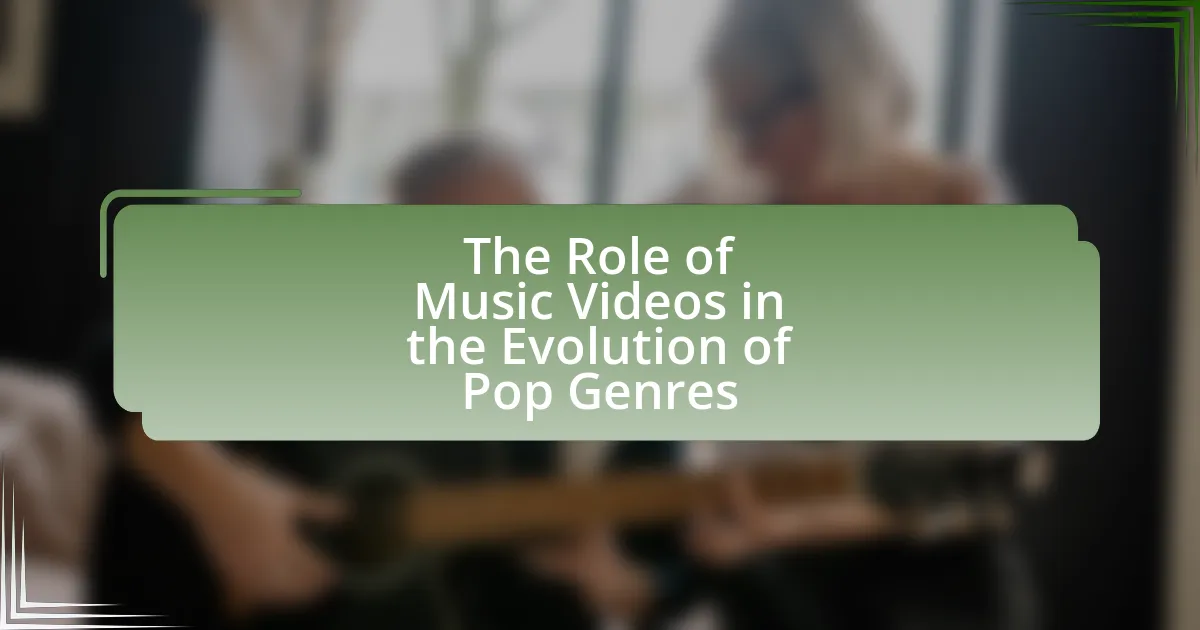The article examines the influence of music criticism on the evolution of pop and rock genres, highlighting how critics shape public perception, guide artist direction, and impact commercial success. It discusses historical examples, such as the rise of punk rock and the critical reception of landmark albums, illustrating how music criticism defines genre boundaries and influences audience engagement. Additionally, the article explores current trends in music criticism, including the role of digital media and social platforms, and their implications for genre development and artist careers. Overall, it emphasizes the dynamic relationship between music criticism and genre evolution, showcasing its significance in shaping the landscape of popular music.

What is the Influence of Music Criticism on Genre Evolution in Pop and Rock?
Music criticism significantly influences genre evolution in pop and rock by shaping public perception and guiding artist direction. Critics often highlight emerging trends, which can lead to increased popularity of specific styles or subgenres, as seen with the rise of punk rock in the 1970s, where critical acclaim for bands like The Ramones and The Sex Pistols helped define and popularize the genre. Additionally, music reviews can impact commercial success; for instance, favorable reviews from influential publications like Rolling Stone can propel albums to higher sales and greater visibility, thus encouraging artists to explore new sounds. This dynamic interaction between criticism and genre development illustrates how critics not only reflect but also actively participate in the evolution of music styles.
How has music criticism shaped the development of pop and rock genres?
Music criticism has significantly shaped the development of pop and rock genres by influencing public perception, guiding artist direction, and impacting commercial success. Critics have historically played a pivotal role in defining what constitutes quality and innovation within these genres, often elevating certain artists and movements while marginalizing others. For instance, the rise of punk rock in the 1970s was propelled by critical acclaim from publications like NME and Rolling Stone, which celebrated its raw energy and anti-establishment ethos, thereby encouraging a wave of similar music. Additionally, music reviews and critiques have informed listeners’ tastes, creating trends that artists often adapt to meet audience expectations. The critical reception of albums, such as The Beatles’ “Sgt. Pepper’s Lonely Hearts Club Band,” not only solidified its status as a landmark record but also set a precedent for artistic experimentation in pop and rock. Thus, music criticism has been instrumental in shaping the evolution of these genres by validating certain artistic choices and influencing the trajectory of popular music.
What role do music critics play in defining genre boundaries?
Music critics play a crucial role in defining genre boundaries by analyzing, categorizing, and labeling music based on stylistic elements and cultural context. Their reviews and critiques often establish the criteria by which genres are understood, influencing both public perception and industry classification. For instance, the emergence of subgenres like grunge or shoegaze was significantly shaped by critics who articulated the distinct characteristics of these styles, thereby solidifying their place within the broader rock genre. This process is evident in publications such as Rolling Stone and Pitchfork, where critics’ assessments have historically guided listeners and artists alike in recognizing and navigating genre distinctions.
How do critics influence public perception of new music trends?
Critics influence public perception of new music trends by shaping narratives and providing authoritative evaluations that guide listener preferences. Through reviews, articles, and social media commentary, critics highlight emerging artists and genres, often framing them within cultural contexts that resonate with audiences. For instance, the rise of indie rock in the early 2000s was significantly propelled by critical acclaim from publications like Pitchfork, which helped establish a mainstream audience for previously niche sounds. This demonstrates that critics not only assess music but also actively participate in the promotion and validation of new trends, ultimately affecting how the public engages with and perceives these musical developments.
Why is music criticism important for artists and audiences?
Music criticism is important for artists and audiences because it provides essential feedback that shapes artistic development and influences public perception. For artists, constructive criticism can highlight strengths and weaknesses in their work, guiding them toward improvement and innovation. For audiences, music criticism offers insights that enhance their understanding and appreciation of music, helping them navigate a vast array of genres and styles. Historical examples, such as the impact of Rolling Stone magazine in the 1960s and 1970s, demonstrate how critical reviews can elevate emerging artists and redefine genres, ultimately influencing the trajectory of popular music.
How does music criticism affect an artist’s career trajectory?
Music criticism significantly influences an artist’s career trajectory by shaping public perception and impacting commercial success. Positive reviews can enhance an artist’s visibility, leading to increased sales and opportunities, while negative critiques can hinder their progress and limit audience reach. For instance, the critical acclaim of albums like “OK Computer” by Radiohead propelled the band to international fame, whereas harsh reviews can lead to a decline in popularity, as seen with artists who struggle to recover from poor reception of their work. Thus, music criticism serves as a crucial determinant in the trajectory of an artist’s career, affecting both their reputation and financial viability.
What impact does criticism have on audience engagement with music?
Criticism significantly influences audience engagement with music by shaping perceptions and guiding listener preferences. When critics provide reviews, they often highlight specific elements of a song or album, which can enhance listeners’ understanding and appreciation of the music. For instance, a favorable review can increase interest and encourage audiences to explore an artist’s work, while negative criticism may deter listeners from engaging with certain genres or artists. Research indicates that music reviews can lead to increased sales and streaming numbers, as seen in the case of albums that receive high ratings from prominent critics, which often experience a spike in popularity shortly after the reviews are published. This demonstrates that criticism not only affects individual listener choices but also has broader implications for the music industry and genre evolution.
What historical context is necessary to understand this influence?
The historical context necessary to understand the influence of music criticism on genre evolution in pop and rock includes the emergence of music journalism in the 1960s, which coincided with significant cultural shifts such as the counterculture movement and the rise of youth culture. Music critics began to shape public perception and appreciation of various genres, influencing artists and record labels. For instance, publications like Rolling Stone and NME played pivotal roles in promoting new sounds and artists, thereby impacting the commercial success and artistic direction of pop and rock music. This period also saw the establishment of music festivals and the integration of music into broader social movements, further highlighting the interconnectedness of music criticism and genre development.
How did early music criticism shape the foundations of pop and rock?
Early music criticism significantly shaped the foundations of pop and rock by establishing standards for musical quality and influencing public perception of emerging genres. Critics in the 1950s and 1960s, such as those writing for publications like Rolling Stone and Billboard, evaluated and contextualized new music, helping to define what constituted “good” music in these genres. This critical discourse not only guided listeners’ tastes but also pressured artists to innovate and refine their sound to meet these expectations. For instance, the backlash against simplistic pop music led to the rise of more complex rock compositions, as seen in the works of artists like The Beatles and Bob Dylan, who were both praised and critiqued for their artistic choices. Thus, early music criticism played a crucial role in shaping the artistic direction and commercial viability of pop and rock music.
What significant movements in music criticism have influenced genre evolution?
Significant movements in music criticism that have influenced genre evolution include the rise of rock criticism in the 1960s and 1970s, the punk rock movement’s challenge to mainstream music, and the emergence of hip-hop criticism in the 1980s. Rock criticism, exemplified by publications like Rolling Stone, shaped public perception and appreciation of rock music, leading to the genre’s diversification. The punk rock movement, with its DIY ethos, prompted critics to reevaluate musical norms and embrace underground sounds, fostering new subgenres. Hip-hop criticism, particularly through platforms like The Source, highlighted the cultural and social contexts of rap music, influencing its acceptance and evolution within mainstream culture. These movements collectively demonstrate how music criticism has played a crucial role in shaping and redefining musical genres over time.
How do music critics adapt to changes in the music industry?
Music critics adapt to changes in the music industry by evolving their evaluation criteria and embracing new platforms for dissemination. As the industry shifts towards digital streaming and social media, critics increasingly utilize online platforms to reach wider audiences, often incorporating multimedia elements such as video and social engagement. For instance, the rise of platforms like YouTube and Spotify has led critics to focus on the accessibility and virality of music, assessing how songs perform in these environments rather than solely relying on traditional album reviews. This adaptation is evidenced by the growing trend of critics engaging with audiences through social media, where they discuss and critique music in real-time, reflecting the immediate feedback loop created by digital consumption.
What specific examples illustrate the influence of music criticism on genre evolution?
Music criticism has significantly influenced genre evolution, with specific examples including the rise of punk rock and the development of alternative rock. The punk rock movement in the 1970s was propelled by critics who championed bands like The Ramones and Sex Pistols, emphasizing their raw sound and anti-establishment ethos, which encouraged a shift away from the polished production of mainstream rock. Similarly, the emergence of alternative rock in the 1980s and 1990s was shaped by critical acclaim for bands like R.E.M. and Nirvana, whose music was often described as a reaction against the commercialism of the era, leading to a broader acceptance of diverse sounds and themes in rock music. These critical endorsements not only validated these genres but also helped to shape their identity and direction, demonstrating the powerful role of music criticism in genre evolution.
How did specific albums or artists change the landscape of pop and rock through criticism?
Specific albums and artists have significantly altered the landscape of pop and rock through criticism by challenging conventional norms and inspiring new directions in the genres. For instance, The Beatles’ album “Sgt. Pepper’s Lonely Hearts Club Band” received critical acclaim for its innovative production techniques and conceptual approach, which prompted a shift in how albums were perceived as cohesive artistic statements rather than mere collections of singles. This critical recognition encouraged other artists to experiment with their sound and presentation, leading to the emergence of progressive rock.
Similarly, Nirvana’s “Nevermind” faced initial skepticism but was later hailed for its raw authenticity and emotional depth, which reshaped the grunge movement and influenced mainstream rock. Critics praised its departure from the polished aesthetics of the 1980s, prompting a wave of artists to embrace a more stripped-down, honest approach to songwriting. This shift was evident in the rise of alternative rock bands in the 1990s, which sought to capture the same spirit of rebellion and authenticity.
Moreover, albums like Beyoncé’s “Lemonade” received critical acclaim for their exploration of race, feminism, and personal narrative, pushing the boundaries of pop music and encouraging discussions around social issues within the genre. This critical engagement not only elevated the album’s status but also inspired other artists to address similar themes in their work, thereby evolving the pop landscape.
In summary, through critical reception and analysis, specific albums and artists have redefined the expectations and artistic possibilities within pop and rock, leading to a more diverse and innovative musical landscape.
What are notable case studies of music criticism impacting genre shifts?
Notable case studies of music criticism impacting genre shifts include the critical reception of Bob Dylan’s “Like a Rolling Stone,” which marked a significant transition from folk to rock music, influencing the genre’s lyrical depth and complexity. Critics hailed the song for its innovative sound and storytelling, prompting artists to explore more profound themes in rock music. Another example is the backlash against disco in the late 1970s, particularly highlighted by the “Disco Demolition Night” in 1979, which reflected a critical shift in public sentiment and led to the decline of disco as a dominant genre, paving the way for the rise of punk and new wave. These instances illustrate how music criticism not only shapes public perception but also catalyzes significant genre transformations.
What are the current trends in music criticism and their implications?
Current trends in music criticism include the rise of digital platforms, increased emphasis on social media engagement, and a focus on diversity and inclusivity in music evaluation. Digital platforms like blogs and YouTube have democratized music criticism, allowing a wider range of voices to contribute, which has implications for genre evolution as emerging artists gain visibility. Social media engagement enables critics to interact directly with audiences, shaping public perception and influencing trends in real-time. Additionally, the focus on diversity encourages the exploration of underrepresented genres and artists, leading to a broader understanding of musical innovation and evolution within pop and rock. These trends collectively reshape the landscape of music criticism, impacting which genres gain traction and how they are perceived culturally.
How has the rise of digital media changed music criticism?
The rise of digital media has transformed music criticism by democratizing access to reviews and enabling a wider range of voices to contribute. Traditional gatekeepers, such as print publications, have been largely replaced by online platforms, allowing independent critics and fans to share their opinions instantly. This shift has led to a more diverse array of perspectives, as evidenced by the proliferation of music blogs, social media commentary, and user-generated content on platforms like YouTube and Spotify. According to a 2021 study by the Pew Research Center, 72% of adults in the U.S. engage with music content online, highlighting the significant impact of digital media on how music is critiqued and consumed.
What role do social media platforms play in contemporary music criticism?
Social media platforms serve as vital channels for contemporary music criticism by enabling immediate feedback and broad audience engagement. These platforms allow critics, artists, and fans to share opinions, reviews, and analyses in real-time, significantly influencing public perception and genre trends. For instance, the viral nature of platforms like Twitter and Instagram can amplify a critic’s review, leading to increased visibility for certain artists or genres. Additionally, data from a 2021 study by the Pew Research Center indicates that 72% of adults use social media, highlighting its role in shaping music discourse and facilitating discussions that can impact an artist’s career trajectory.
What practical insights can be drawn from the influence of music criticism on genre evolution?
Music criticism significantly shapes genre evolution by guiding public perception and influencing artist direction. Critics often highlight emerging trends, which can lead to the popularization of specific styles, as seen in the rise of punk rock in the 1970s, where critical acclaim for bands like The Ramones and The Sex Pistols helped define the genre. Furthermore, music reviews can create a feedback loop; positive criticism encourages artists to explore new sounds, while negative reviews may push them to refine or abandon certain elements. This dynamic is evident in the evolution of hip-hop, where critical reception of albums like Kendrick Lamar’s “To Pimp a Butterfly” has influenced both the genre’s thematic depth and its musical experimentation. Thus, music criticism serves as both a mirror and a catalyst for genre development, shaping the landscape of pop and rock music.




